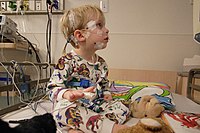
Photo from wikipedia
OBJECTIVE To explore how subjective and objective sleep parameters respond to bilateral subthalamic nucleus-deep brain stimulation (STN-DBS) in patients with Parkinson's disease (PD). METHODS Thirty DBS sleep studies were included… Click to show full abstract
OBJECTIVE To explore how subjective and objective sleep parameters respond to bilateral subthalamic nucleus-deep brain stimulation (STN-DBS) in patients with Parkinson's disease (PD). METHODS Thirty DBS sleep studies were included by searching PubMed, Embase, and the Cochrane Library, and only 21 prospectively designed studies, including 541 patients, were eligible for the main analysis. We evaluated sleep disturbance using 1 objective measurement, polysomnography (PSG), and 4 subjective scales, including PD Sleep Scale (PDSS), Pittsburgh Sleep Quality Index (PSQI), Epworth Sleepiness Scale (ESS), and restless legs syndrome (RLS). We pooled data using the standard mean difference (SMD). The primary outcome was a change in sleep parameters 6 months postoperatively. Outcomes from <12 months to ≥12 months follow-up were compared in the subgroup analysis. Meta-regression was further conducted. RESULTS STN-DBS significantly improved all 4 subjective sleep scales in the 6-month follow-up: ESS (SMD = 0.234), PDSS (SMD = 0.724), PSQI (SMD = 1.374) and RLS (SMD = 1.086), while most PSG parameters remained unchanged, except for shortened rapid eye movement sleep latency (RSL) (SMD = 0.520). In the over-12-month follow-up, improvement persisted in PDSS but not in ESS. Dopamine drug reduction (p = 0.009) and motor improvement (p = 0.036) were correlated with ESS improvement and PDSS improvement, respectively. CONCLUSIONS Bilateral STN-DBS continuously improved subjective nocturnal sleep, while its effect on ESS lasted for only 1 year. Medication reduction and motor improvement may contribute to improved daytime sleepiness and better subjective nocturnal sleep, respectively. Except for a shortened RSL, STN-DBS did not change PSG parameters, including sleep efficiency and sleep architecture. REGISTRATION Open Science Framework: DOI 10.17605/OSF.IO/3EGRC.
Journal Title: Sleep medicine
Year Published: 2020
Link to full text (if available)
Share on Social Media: Sign Up to like & get
recommendations!